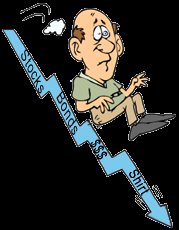Mutual fund promoters always highline the fund is managed by professionals. The first impression you get when you talk about professionals is they are truly professional, meaning that they are devoted their time for the fund management as well as they are equipped with necessary knowledge and skills. This should at least beat down average Joe result in the investment. But, the impression we get not always represent true reality. Checking back to the history and you found out that they are so many fund managers who do not perform, not even by laymen in the street. The reasons? There are too many and I just want to highlight few.
1) Peer pressure
There are 4 variables for the investment results and its outcomes:
i) You are right, others are right: that’s great! You deliver the results as expected.
ii) You are right, others are wrong: that’s even superb! You are among the top of the tops who delivers superior results.
iii) You are wrong, others are wrong: hmmm….. because of unforeseen circumstances such as 9-11 Tragedy, Hurricane Katrina, Tsunami…etc that could not be avoided, thus, delivering the poor results. Since everyone delivers same poor results, no one will blame you.
iv) You are wrong BUT others are right: oooooops…. That’s disastrous. Why you deliver such poor performance while others could deliver a handsome return? Everyone pinpoint at you and you are no way to hide because figures show everything. How? How do you avoid such phenomenon?

If you are the fund manager, which one would be preferred and which one you try to avoid far away? Since the management fee is not based on performance merit, isn’t it PLAY SAFE a better idea? If I could deliver a handsome results, that’s the desired outcome. But, if to deliver such results posses a risk of delivering a poor result compared to others who don’t, I’m better protecting my position first. After all, management fee is sure thing while to be a super star might risk me losing out my rice bowl!
2) Ego
Many fund managers are graduated from Ivy League. They are full of titles and they might be a Nobel Prize winner as well. Take an example, 2 Nobel Prize winning economists with other elite academic traders manage Long Term Capital Management (LTCM). Even with so many highly educated and intelligent people, the fund still failed. As mentioned by Warren Buffett, to ensure a successful investment result, you do not need a rocket scientist, but a Grade 6 mathematics with a rational business thinking.
Next time, whenever mutual fund salesmen try to persuade you to buy from him, ask him about Sales Load, Management Fee, Trustee Fee and so forth and their impact to your investment result. Are they care about the impact? How about their net worth? Are their majority net worth placed where they promote? If not, then why? All in all, is up to you – what’s your objective of your investment in mutual fund? To please somebody, buy it because of relationships, such as family members, friends or colleagues? Or because you really look for the one who could preserve your asset as well as creating value for you? After all, it’s your money and it’s your responsibility to take care of it, if not you, who else?

“Be a man. Place your money where’s your mouth is.” This is what I want to share with all fund managers….
Technorati Tags: Investment, Mutual Fund, Unit Trust, Professional, Peer Pressure, Ego, Play Safe, Ego, Ivy League, Long Term Capital Management, LTCM, Nobel Prize, Warren Buffett, Sales Load, Management Fee, Trustee Fee, Man, Money













